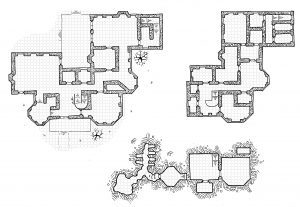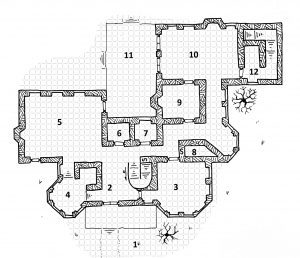 The Kobold King, in his scaly wisdom, became a patron of the famed cartographer, Dyson Logos (Fantasy RPG Cartography by Dyson Logos)! Magnificent maps were attained, thereby, which our Squamous Sovereign decreed would become part of the landscape of Midgard. With great celerity and a stolen thesaurus, one of his minions did set about transforming his liege’s will into stone, earth, wood, water, fur, flesh, bone, blood, and various pieces of tasteful and expensive furniture.
The Kobold King, in his scaly wisdom, became a patron of the famed cartographer, Dyson Logos (Fantasy RPG Cartography by Dyson Logos)! Magnificent maps were attained, thereby, which our Squamous Sovereign decreed would become part of the landscape of Midgard. With great celerity and a stolen thesaurus, one of his minions did set about transforming his liege’s will into stone, earth, wood, water, fur, flesh, bone, blood, and various pieces of tasteful and expensive furniture.
Part One: The Village of Sulca
The tiny village of Sulca consists of several old, largely unadorned houses and a few essential businesses, all huddled together, cheek by jowl, between several farms. It could only appear more unwelcoming were it under arms or on fire. What once might have been the village’s only tavern now serves as a shelter for goats. There is a smithy, a farrier, and livery, but little else, and nothing to interest or accommodate a traveler. And absolutely nothing that would require anyone to be out and about in the evening.
By day, the people of Sulca have little to nothing to say to strangers, and by night, they never open their doors. They will tell anyone the name of their ruler, Lady Ilinca, and the name of her house, White Rose Manor. They will not speak of the Blood Lord. Neither will they complain about anything, but the fear in their speech and look is palpable. They are pained by interaction with outsiders, afraid that doing so might draw unwanted attention their way.
The village itself contains nothing of interest to the PCs unless they decide to steal horses. They would meet no resistance since the stable keeper fears to lock his paddocks for fear of offending the nobility, should they decide to take a horse. The livery is currently occupied by three old, swaybacked Kariv carthorses and a barely mature Morgau ghost horse, which is large enough to ride but completely untrained for it.
A lazily winding path leads up a hill to a stately manor house.
Morgau Ghost Horses: These horses are sometimes thought to be undead: they certainly look it, in flecked gray or all black, with wild red eyes and white manes. However, the ghost horse is a living animal and capable of incorporeal movement once each day if its rider succeeds on a DC 20 Animal Handling check. It returns to corporeality on the rider’s command or when 3 rounds have passed (see Midgard Campaign Setting, pg. 149).
Incorporeal Movement. The Morgau ghost horse can move through other creatures and objects as if they were difficult terrain, taking 5 (1d10) force damage if it ends its turn inside an object.
 The Manor
The Manor
All windows in the manor are thick, opaque leadlight unless otherwise noted.
All rooms are unlit unless otherwise noted.
-
The Front Lawn
The path leading from the main road winds its way up the hill to a small, two-story manor house. A mature black locust tree stands to one side of a large uncovered porch. A tasteful wooden sign reads in flowing script, “Please, do not tread on the lawn.”
Trap!
Exsanguinating Grass
Natural trap
The only real indicator of something amiss is a small collection of dead birds near the base of the tree, detectable with a DC 20 Perception check. Any creature stepping onto the lawn quickly discovers that many of the blades of grass conceal needle-like, hollow spines capable of penetrating a boot and the foot within. Living creatures stepping on the grass must make a DC 15 Dexterity saving throw, taking 7 (2d6) piercing damage and becoming grappled (escape DC 14), or half the damage and avoid the grappled condition on a successful one.
When the grass draws blood from a creature, the color of the lawn pulses red in an outward-flowing ring from the point of contact before returning to its normal green. The grass covers the entire surface of the grid on the map except for the walkway, the porch, and the manor itself.
The oaken double door is closed and locked, requiring a DC 17 Disable Device check to unlock.
-
The Foyer
The plaster walls of the entry chamber are painted with a pattern of black vines and white roses, rising to the ceiling above where several blooms open to stylized moon at the apex, which gives off a dim but not unpleasant illumination.
Around the corner from the foyer, there is a locked and trapped secret door, detectable with a DC 15 Perception check. The door opens to reveal a staircase leading down to the cellar.
Near that is another secret door leading to Area 8.
Trap!
Release-the-Hound Trap
Mechanical Trap
The lock can be opened with a DC 25 Disable Device check (or with the key upstairs), and the trap can be detected with a DC 15 Investigation check, revealing a small stud on the doorjamb that must be held down with twenty pounds of weight to neutralize it. Disabling it altogether requires a DC 20 Disable Device check. If the trap is triggered, the door to Area B5 (in Part 3) opens long enough to release the pair of lich hounds there, which arrive at the trigger location in two rounds with an action remaining.
Lich Hound
Their howls echoing from another plane, lich hounds always arrive wreathed in mist. Half bone, half purple fire, they are creatures of hunger and the hunt. Nothing makes them happier than taking down creatures larger than themselves—or racing through the air to catch a surprised bat in mid-flight. All cruelty and fang, lich hounds are only happy when praised by their great undead lords.
Fiery Bones. Bright white skulls with a heavy jaw and thick, robust skeletal bodies define the ferocious lich hounds. Their eyes burn green or blue, and their tongues resemble black fire. Fueled by necromantic power, these creatures are loyal servants of either ghoul high priests or liches.
Echoing Howls. Even on their own, lich hounds are relentless hunters, pursuing their prey with powerful senses and a keen ability to find the living wherever they may hide. Lich hound howls fade into and out of normal hearing, with strangely shifted pitch and echoes.
Murdered Celestials. The dark process of creating a lich hound involves a perverse ritual of first summoning a celestial canine and binding it to the material plane. The hound’s future master then murders the trapped beast. Only then can the creature be animated in all its unholy glory. Hound archons have long been outraged by the creation of lich hounds, and they occasionally band together to rid the world of those who practice this particular dark magic.
Lich Hound
Medium undead, neutral evil
Armor Class 14
Hit Points 119 (14d8 + 56)
Speed 30 ft., fly 50 ft.
| STR | DEX | CON | INT | WIS | CHA |
| 10 (+0) | 18 (+4) | 18 (+4) | 6 (–2) | 10 (+0) | 16 (+3) |
Saving Throws Dex +4, Con +4, Cha +3
Skills Acrobatics +6, Perception +4
Damage Resistance piercing and bludgeoning from nonmagical weapons
Damage Immunities poison
Condition Immunities exhaustion, poisoned Senses blindsight 100 ft., passive Perception 14 Languages understands Darakhul
Challenge 4 (1,100 XP)
Keen Hearing and Smell. The lich hound has advantage on Wisdom (Perception) checks that rely on hearing or smell.
Actions
Bite. Melee Weapon Attack: +6 to hit, reach 5 ft., one target. Hit: 10 (1d12 + 4) piercing damage. If the target is a creature, it must succeed on a DC 14 Strength saving throw or be knocked prone.
Ethereal Jaunt. As a bonus action, the lich hound can magically shift from the Material Plane to the Ethereal Plane, or vice versa.
Gut Rip. As a bonus action, the lich hound tears into any adjacent prone creature, inflicting 19 (3d12) slashing damage. The target must succeed on a DC 14 Constitution saving throw or be incapacitated for 1d4 rounds. An incapacitated creature repeats the saving throw at the end of each of its turns; a successful save ends the condition early.
Howl. The eerie howl of lich hounds as they close in on their prey plays havoc on the morale of living creatures that hear it. Howling requires and action, and creatures that hear the howl of a lich hound within 100 feet must succeed on a DC 14 Wisdom saving throw or become frightened for 5 rounds. Creatures that successfully save against this effect cannot be affected by a lich hound’s howl for 24 hours.

Lich Hounds are a cool idea.